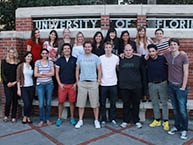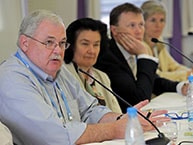inBRIEF Newsletter
Published annually, inBRIEF is a report by the International Accounting & Auditing Center. The newsletter strives to keep its readers informed of the activities of the Center. Each issue will also provide an in-depth focus on key topics in accounting and auditing, taking a relevant professional or practice topic and summarizing the existing research on that topic in non-technical terms.
News id="news"
International Accounting & Auditing Center Renovations

An important and welcome development is that the Center has a new space. We’ve moved into a suite of offices on the second floor of Gerson Hall after renovating the Andersen reading area that was rarely used by students. The suite is now the focal point for the Center’s activities and includes an office for international visitors. Please stop by if you are on campus. We are slowly collecting and displaying various mementos of our six years of activities.
Collaboration leads to creation of international master’s program

The master plan for the Center originally called for a student study abroad program, but this has been more effectively and efficiently handled by the Warrington College of Business. However, 2012 did see a significant advance on the education front when we launched the first cohort of the new International Executive in Auditing Masters program, offered in conjunction with Maastricht University and the Free University of Amsterdam. At this time, the students are all European and are officially enrolled at Maastricht University. However, in January 2013, we had the pleasure of hosting the students for two weeks of concentrated class work. By all reports, the students thoroughly enjoyed the experience. The average student in the program speaks three languages and has at least three years of experience in public accounting. Upon completion of the program, students receive a master’s degree from Maastricht, become licensed auditors in the Netherlands and are eligible to become licensed in Florida and the UK. The multi-jurisdictional aspects of the program make it truly unique. Moving forward, Fisher Lecturer Chris Falk will take over the liaison duties through the Center.
International Outreach id="international-outreach"

The Center fulfills its outreach mission in two primary ways: (1) through an exchange program for international accounting scholars and (2) through professional speaking opportunities. One aspect of our exchange program that has grown is support for Fisher faculty and Ph.D. students who wish to go abroad in order to expand their research opportunities. The first such exchange involved Stephen Brown, a doctoral student who spent three months at Maastricht University to work on his dissertation. In 2013, we will also support another doctoral student, Will Ciconte, who will be visiting KU Leuven just outside of Brussels. We hope to eventually establish a source of funding that will support such activities on an ongoing basis, and be available to new faculty at Fisher.
Advancing the Center’s outreach mission here in Gainesville, it hosts Visiting Scholars and International Visitors. Visiting Scholars are advanced Ph.D. students or recent graduates who wish to gain international research experience. The Center hosted three Visiting Scholars in 2012: Nadine Funcke (Maastricht University), Kris Hardies (Free University of Brussels) and Xiaobei (Beryl) Huang (University of International Business & Economics at Beijing).
The Center also welcomed Marleen Willekens, a professor of Accounting and Auditing and AFI department chair at KU Leuven (Belgium), as a Seminar Visitor. Seminar Visitors are experienced scholars who visit for a short term—usually one week or less—and present to Fisher’s faculty.
You can read more about these brilliant international scholars.
Regarding speaking opportunities, I am frequently invited to give speeches at international conferences. I’ve presented at various functions of the American Accounting Association, the European Accounting Association—most recently in Ljubljana, Slovenia (pictured above)—and the Accounting and Finance Association of Australia and New Zealand (most recently in Darwin, Australia). I have also had the opportunity to be the keynote speaker at a few large forum conferences. In 2011, I spoke on the topic of “Rethinking Audit Quality” at the Audit Quality Conference in Bellagio, Italy, co-sponsored by the European Institute of Advanced Studies in Management (EIASM) and Bocconi University (Milan). In 2012, I spoke at the World Congress of the International Association of Accounting Education and Research in Amsterdam. The topic of that speech was “The Future of Auditing”. In 2013, I will speak at the annual national conference of CPA Australia in Melbourne on the topic of “Is the Auditing Profession Sustainable?”
Research Activities id="research-activities"
European Union Auditing Standards
The Center has been most active on the research front. In my last report, I talked about a project that we were working on in collaboration with Maastricht University for the European Commission involving the evolution of auditing standards in the European Union. That project culminated in a comprehensive report that concluded that while there were a few significant differences between US and international auditing standards—reporting on internal control and group audits being the primary differences—the costs of dual compliance for cross-listed corporations were not high since most international accounting firms are routinely in compliance with both sets of standards when conducting a global audit. Further, we found no evidence that users of financial statements believed that different standards led to different quality audits. That was the first official project conducted by the Center, and was considered to be successful by the European Directorate for Internal Markets.
Study: What is Audit Quality?
In January 2012, the Center, in collaboration with audit scholars from a number of universities, addressed the question “What is audit quality” at the request of the Public Company Accounting Oversight Board (PCAOB)[1]. After examining the very large literature on audit quality, the team concluded that audit quality is, in fact, unobservable. Further, there is no generally accepted definition of audit quality although there are two broadly cited definitions mentioned by academics and professionals. The most common academic definition of audit quality is the market assessed likelihood that an auditor detects and corrects or reports material misstatements in the financial statements. The profession’s definition is best reflected in the third standard of fieldwork, namely, audit quality implies that the financial statements are supported by sufficient competent evidence. The former definition is outcome oriented while the latter is process oriented.
It seems that “audit quality” may very much be in the eye of the beholder. Regulators might consider a quality audit to be one that is standards-compliant and passes inspection. Audit partners may consider a quality audit to be one where there are few problems. Financial statement readers may consider a quality audit to be one where there is no fraud or material misstatement.
Finally, the researchers concluded that audit quality cannot be measured or captured in a single metric. Ultimately, audit quality reflects that interaction of a number of attributes inherent in the audit itself: (1) the incentives and motivations of the auditor, (2) the uncertainty of the subject matter, (3) the uniqueness of each client, (4) the formality and structure of the process and (5) the exercise of professional judgment. A breakdown in any of these attributes could lead to a loss of audit quality.
Given this diversity of viewpoints, the research team concluded that the best way to measure audit quality is through a balanced scorecard with four elements: (1) input, (2) process, (3) outcomes and (4) context. Input refers to the nature and extent of expertise, staffing and independence of the audit team. Process refers to the appropriate utilization of professional judgment, methods for assessing risk and examining analytical evidence, negotiating adjustments with the client and internal quality controls. The outcomes of the audit include both short-term metrics such as the auditor’s opinion and measures of financial reporting quality, as well as longer-term metrics such as client failure, litigation or accounting restatements. All audit decisions occur within a specific context so it is also important to understand how engagements can be affected by partner compensation practices, fee levels, non-audit services and auditor tenure. The four categories of metrics, when taken together, can provide a rich view of audit quality. It is something that, in the end, is inherently unobservable in its totality.
Footnotes:
- Knechel, W. R., G. V. Krishnan, M. Pevzner, L. Shefchik, and U. Velury. 2013. Audit quality: Insights from the academic literature. Auditing: A Journal of Practice & Theory 32 (Special Issue). Back to content
Study: Should Audit Partner’s sign the Audit Opinion Personally?
A current hot topic in US audit regulation is whether or not an individual audit partner should sign his or her name (in addition to the firm name) on the audit report for a public registrant that is under the regulatory authority of the Securities and Exchange Commission (SEC) and the Public Company Accounting Oversight Board (PCAOB). Such requirements already exist in Australia and most of Europe. The essence of the debate is whether the public identification of the audit partner responsible for an engagement provides useful information to the readers of financial statements and makes the individual partners more accountable. Historically, the accounting profession has resisted such a requirement in the US. In order to shed some light on the issue, the Center, in conjunction with the University of Vaasa (Finland) and Maastricht University (Netherlands), undertook a study examining Swedish audit partners in the Big 4[2].
Sweden provides an appropriate market for the study because they require identification of the signing audit partner, and any company with more than five employees must produce publicly-available audited financial statements. This results in an extremely rich and comprehensive database to examine. The researchers were able to identify the entire client portfolio of each audit partner of the Big 4 for a period of 10 years, yielding more than 20,000 audit reports issued by more than 450 unique audit partners identified by name and firm.
If disclosure of the signing partner is useful, we should observe systematic variations in audit quality across audit partners and not just audit firms. That is, if audit quality is not simply randomly distributed across audit partners, then knowing the identity of the audit partner may provide potentially useful information to financial statement users.
Based on measures of the likelihood of issuing going-concern opinions to financially distressed clients, and the quality of earnings which receive a clean auditor’s report, we find that audit partners with less-than-average performance for one client in one year are more likely to have less-than-average performance in future audits of the same client and other clients in the auditor’s client portfolio. In short, audit quality appears to be inherently linked to the identity of individual audit partners. Note, the study does not conclude that any partners are delivering substandard audit quality. Rather, the study simply concludes that there are variations in auditor judgment. This phenomena occurs after controlling for the innate riskiness of individual clients and in spite of the various monitoring controls used by audit firms to limit diversity of practice (e.g., structured audit methodologies, second partner reviews, and internal quality reviews).
Should the PCAOB require audit partners to sign the opinion? Possibly. This study suggests that such information could be useful. However, consideration of such a policy should also consider the costs of such a disclosure, something this study cannot address.
Footnotes:
- Does the Identity of Engagement Partners Matter? An Analysis of the Persistence and Economic Consequences of Low Partner Audit Quality” by W. R. Knechel, A. Vanstraelen and M. Zerni (working paper, 2013, available from the Center). Back to content
On the Road id="on-the-road"
Ljubljana, Slovenia (j’s are silent)

Located in the heart of Slovenia is the capital city of Ljubljana. It is a mid-sized city with roughly twice the population of Gainesville. Like Gainesville, it also has a “young vibe” that stems from a large student population at the University of Ljubljana. The country of Slovenia is surrounded by Italy, Austria, Hungary and Croatia leading to great diversity within its people, culture and cuisine. Slovenia is situated in Central Europe along a small portion of the Adriatic Sea. Here, the Alps meet the Mediterranean Sea and the Pannonian Plain meets the Karst. (Incidentally, Karst topography is named for the Kras plateau region of eastern Italy and western Slovenia.) Because of Ljubljana’s central location, it is an ideal base from which to explore the region.
On a recent trip to Ljubljana, I was hosted by the Slovenian Institute of Auditors. I had the pleasure of dining with Karel Van Hulle, former Head of Unit for Accounting and Auditing in the Directorate of Internal Markets in the EU.
Ljubljana is one of the many destinations where the Center has been invited to speak. In upcoming months, I will be speaking in Perth, Australia; Helsinki, Finland; Trier, Germany; and Melbourne, Australia.
Did You Know? id="did-you-know"
How Much Does IFRS Cost? A Look at Its Impact on Audit Fees
Regulatory bodies such as the Financial Accounting Standards Board (FASB) often cite the need for cost-benefit analysis when considering a proposed standard. However, standard setters are inherently limited in their ability to perform such evaluations. Still, analysis is possible, and there have been several studies which have attempted to test standard-setting issues. One current topic getting some attention is the adoption of International Financial Reporting Standards (IFRS). Much of the research has been mixed, showing both benefits and costs of moving to IFRS. A study by DeGeorge, Ferguson, and Spear (The Accounting Review 2013) has specifically looked at the effect of IFRS on audit fees.
The authors use a dataset consisting of Australian publicly-listed companies in order to test whether IFRS leads to higher than expected audit fees. They document that post-IFRS audit costs are, on average, significantly greater, and they estimate that fees increase approximately 23 percent relative to the pre-IFRS period. Furthermore, the study shows that the increase in audit fees is greatest for small firms. The study also includes a survey of practicing auditors and the results indicate that firms that are exposed to more audit complexity (i.e. hedge accounting or possible goodwill impairment) are likely to experience higher audit costs due to the extra auditor effort needed. Using the survey, the authors create an IFRS exposure score, and find that audit fees increase when firms are more likely to be affected by the standard change. The authors acknowledge that audit fees are probably not the most significant cost of adoption of IFRS, but point out that given the increases related to audit fees there are likely to be even greater internal costs to firms. Overall, the study demonstrates that not all companies will be affected equally by the implementation of IFRS and regulators should be aware of this when considering IFRS convergence.
